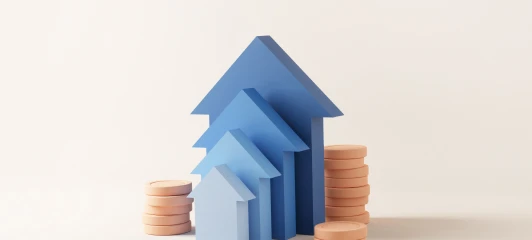4 ways to slash your home loan interest bill by up to $347,779
The rapid pace of interest rate hikes by the Reserve Bank of Australia (RBA) has led to significantly steeper interest bills and mortgage repayments for many borrowers. In April 2022, a borrower with a $600,000 loan over 30 years with an average variable rate of 2.98% was paying $308,336 in interest over the life of the loan, according to Canstar. With the average variable rate on Canstar's database now sitting at 6.90% the interest bill for a borrower who took out that loan today would be $822,576 - that's $514,240 more interest over the life of the loan. The monthly mortgage repayment would also be higher - $3,952 instead of $2,523.
It's little surprise then to hear that many household budgets are feeling the pinch of higher mortgage repayments. The latest research from Roy Morgan reveals that 1.6 million or 31.4% of mortgage holders are at risk of mortgage stress. The good news is there are strategies you can deploy to shrink your interest bill and keep more money in your pocket. Let's take a look at four of these and how much you could potentially save.
1. Add money from cashback sites to your mortgage
Using cashback to help repay your home loan is a simple and hassle-free way of chipping away at your interest bill. Cashback providers receive a commission from retailers when you buy something using their platform. A portion of that commission, usually a percentage of the purchase price, is then passed onto you.
Companies such as Grow Your Money deposit that cash straight back into your home loan or superannuation account. If you use a different provider, such as ShopBack or Cashrewards, the cashback is deposited into a savings account which you can then contribute to your mortgage on your own.
Research from Canstar shows that on a $600,000 home loan over 30 years at the average variable rate of 6.90%, you could potentially reduce your total interest bill by $39,539 if you added $50 cashback to your home loan each month. And the time taken to repay the loan would fall by 14 months.
Adding $50 cashback into your mortgage each month
|
|
No cashback |
Use $50 cashback |
|
Monthly repayment |
$3,952 |
$4,002 |
|
Total interest cost |
$822,576 |
$783,037 |
|
Interest saved |
- |
$39,539 |
|
Repayment time |
30 years |
28 years, 10 months |
Source: www.canstar.com.au - 2/04/2024. Repayments based on 6.90% variable rate.
Potential savings: $39,539
2. Switch to a no-frills basic loan with your current lender
It's easy to be left feeling confused by the seemingly endless features available on mortgages. Bonus points, offset accounts, redraw facilities, split loan options and lump sum repayments are just some of the various benefits available to borrowers. But they also come at a cost. Canstar's research shows there is an average 0.23 percentage point difference between a lender's lowest standard variable loan and their basic variable rate loan without all the bells and whistles.
Applying this discount to the average variable rate of 6.90%, the new interest rate would be 6.67%. On a $600,000 loan over 30 years, this would result in a new monthly repayment of $3,860 (a saving of $92 a month) and $33,071 less interest payable over the life of the loan.
Assuming you could afford to maintain the original monthly repayment of $3,952 on the new basic variable rate of 6.67% the savings would be even bigger. It would also result in an extra $65,426 less interest payable. In total, you could save $98,497 over the life of the loan by choosing a basic home loan while maintaining the existing repayment. The loan would also be paid back two years quicker.
Switching to a no-frills basic loan
|
|
Average rate loan1 |
Refinance to a basic loan (-0.23%2)
|
|
|
Pay lower repayments |
Make the same monthly repayments |
||
|
Monthly repayment |
$3,952 |
$3,860 |
$3,952 |
|
Total interest cost |
$822,576 |
$789,505 |
$724,079 |
|
Interest saved |
- |
$33,071 |
$98,497 |
|
Repayment time |
30 years |
30 years |
28 years |
Source: www.canstar.com.au - 2/04/2024. 1Average rate of 6.90% based on an 80% LVR. 2Calculated based on the difference in the rate of a provider's lowest rate standard home loan against their lowest rate basic loan.
Potential savings: Up to $98,497
3. Make fortnightly repayments on your home loan
One of the most effective methods of reducing your interest bill is by making the switch from monthly to fortnightly repayments. The key is to make sure you take the original repayment amount and divide it by two to work out the fortnightly repayment. Because there are 26 fortnights a year, this is the equivalent of making 13 monthly repayments rather than the initial 12. More simply, you're making an extra monthly repayment spread across the year.
So on a $600,000 loan over 30 years with a 6.90% variable rate, the repayment is $3,952. Dividing this by two gives a fortnightly repayment of $1,976. This strategy would reduce the total interest bill by $209,129 over the life of the loan and results in the loan being repaid six years and seven months sooner.
If you were to instead opt for the original monthly repayment, multiply it by 12 and then divide by 26, the savings would be significantly less attractive. The fortnightly repayment would now be $1,824 and the total interest payable would be reduced by just $17,364.
Making fortnightly repayments on your home loan
|
|
Monthly repayments |
Half monthly repayment |
|
Monthly repayment |
$3,952 |
$1,976 |
|
Total interest cost |
$822,576 |
$613,447 |
|
Interest saved |
- |
$209,129 |
|
Repayment time |
30 years |
23 years, 5 months |
Source: www.canstar.com.au - 2/04/2024. Repayments based on 6.90% variable rate.
Potential savings: Up to $209,129
4. Refinance to a cheaper home loan
Refinancing can be an arduous process. Contacting brokers, negotiating with banks, reviewing loan terms and signing papers are activities few of us enjoy. However, even though the interest rate margin between existing and new loans is much lower than it was 12 months ago, refinancing can still be a good way to save money. With eligible borrowers still able to secure home loans beginning with a five, now's the time to negotiate a better deal.
Research from Canstar reveals the lowest ongoing variable in the market is 5.75% compared to 6.90% for the average variable rate loan. Assuming you had a $600,000 loan over 30 years you could potentially reduce your total interest bill by $162,059 by switching to the lowest rate. The monthly repayment would decrease from $3,952 to $3,501, leaving you $451 a month better off.
If you were able to maintain the existing monthly repayment of $3,952 on the cheaper loan, you could cut an extra $185,720 in interest off the life of the loan. That's a total saving of $347,779 or a 42% reduction in the total mortgage interest payable. Another bonus is that the loan would be paid seven years and four months sooner.
Keep in mind there may be fees that come with refinancing. Assuming an average application fee of $515 and a $335 discharge fee, the cost of refinancing a mortgage to the lowest variable rate would be recouped after two months.
Refinancing to a cheaper home loan
|
|
Average rate loan1 |
Refinance to the lowest rate loan2
|
|
|
Pay lower repayments |
Make the same |
||
|
Monthly repayment |
$3,952 |
$3,501 |
$3,952 |
|
Total interest cost |
$822,576 |
$660,517 |
$474,797 |
|
Interest saved |
- |
$162,059 |
$347,779 |
|
Repayment time |
30 years |
30 years |
22 years, 8 months |
Source: www.canstar.com.au - 2/04/2024. 1Average rate of 6.90% based on an 80% LVR 2 Lowest rate of 5.75% based on any LVR.
Potential savings: Up to $347,779
Frequently Asked Questions about this Article…
Cashback sites can help reduce your home loan interest bill by allowing you to earn cashback on purchases, which you can then apply directly to your mortgage. For example, adding $50 cashback to your home loan each month could save you $39,539 in interest over the life of a $600,000 loan.
Switching to a no-frills basic loan can lower your interest rate and reduce your total interest payable. By opting for a basic loan with fewer features, you could save up to $98,497 in interest over the life of a $600,000 loan, and pay off your mortgage two years earlier.
Making fortnightly repayments instead of monthly ones can significantly reduce your interest bill. By paying half of your monthly repayment every two weeks, you effectively make an extra monthly payment each year, which can save you up to $209,129 in interest and shorten your loan term by over six years.
Refinancing to a cheaper home loan can be worth the effort, as it can lead to substantial savings. By switching to a loan with a lower interest rate, you could save up to $347,779 in interest over the life of a $600,000 loan and pay off your mortgage over seven years sooner.
Before refinancing, consider the potential savings against any fees involved, such as application and discharge fees. Ensure that the savings from a lower interest rate outweigh these costs, which can typically be recouped within a few months.
By maintaining your original repayment amount after refinancing to a lower interest rate, you can significantly increase your savings. For instance, on a $600,000 loan, you could save an additional $185,720 in interest, totaling $347,779 in savings.
Interest rate hikes can dramatically increase mortgage repayments. For example, a $600,000 loan at a 6.90% interest rate results in a monthly repayment of $3,952, compared to $2,523 at a 2.98% rate, leading to a much higher total interest bill over the loan's life.
You can calculate potential savings by comparing different strategies, such as using cashback, switching to a basic loan, making fortnightly payments, or refinancing. Each strategy offers different savings, which can be calculated based on your loan amount, interest rate, and repayment terms.
















